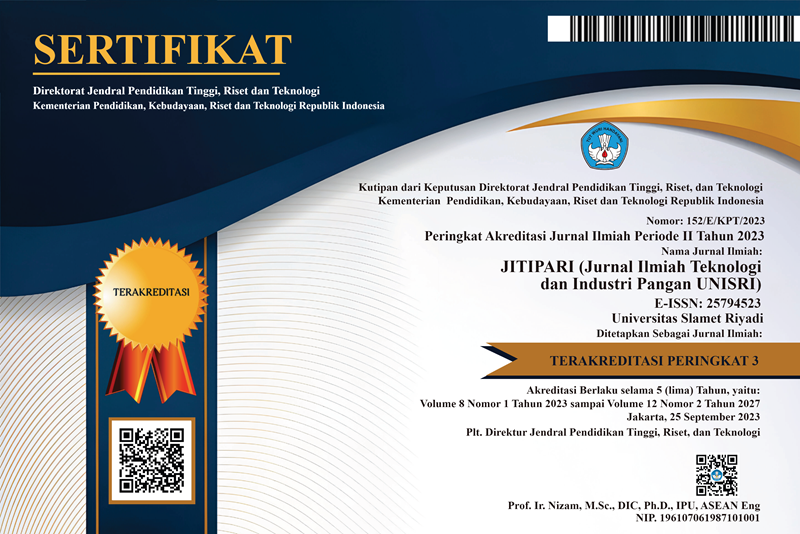The Characteristic of Sticks Mung Bean Flour (Vigra radiate L.) and The Addition of Celery (Apium graveolens)
DOI:
https://doi.org/10.33061/jitipari.v8i2.7240Abstract
Sticks are delicious, crunchy, savory, long, thin, and brownish yellow snacks with various flavors. The main ingredients of this product consist of wheat flour, , eggs, garlic, pepper, and salt. Celery leaves were chosen because they are easy to obtain and to optimize local ingredients. Mung bean (Phaseolus radiates) itself is a vegetable food that is high in protein and fiber where the protein contained is 20-25%. This study aims to determine the effect of sticks mung bean flour and the addition of celery. The design used was a 2 factor factorial completely randomized design (CRD). Factor 1 is the ratio of wheat flour : mung bean flour (75:25, 50:50, 25:75) and factor 2 is the concentration of celery porridge (10%, 20%, 30% in 30 ml of water). The best results of chemical analysis based on the highest protein content were the ratio of wheat flour : mung bean flour 25:75 with concentration of celery porridge 20% with 2.22% water content, 1.74% ash content, 23.58% fat content, 17.75% protein content, 8.28% crude fiber and 46.41 for carbohydrates by difference, color sensory test value 3.73 (greenish brown), crunchy texture 3.40 (crispy), celery taste 3.60 (taste celery flavor) mung bean taste 2.67 (a bit of green bean flavor), celery aroma 3, 33 (smelling of celery), and 3.27 (preferred) for overall liking. The most preferred formulation of celery sticks by consumers is the comparison of wheat flour : mung bean flour 75:25 with the addition of 10% celery porridge concentration with a value of 3.47 (preferred). Sticks made from green beans and celery can be an alternative food that is high in protein and fiber.
References
Achmadi, S. (2019). Pengaruh perbandingan tepung terigu dengan tepung talas (Colocasia esculenta L.) dan konsentrasi puree wortel (Daucus carota L.) terhadap karakteristik makaroni. Skripsi. Bandung, Indonesia: Universitas Pasundan.
Ambarita, L., Setohadi, & L. N. Limbong. (2013). Pengaruh variasi lama pengukusan dan lama penggorengan terhadap mutu kerupuk biji durian. Jurnal Rekayasa Pangan dan Pertanian. 1(2): 12-18
AOAC. (1997). Official Method of Analisis of The Association of Official Analitycal Chemist. In Washington DC. USA: Benyamin Franklin
BPS. (2019). Statistik Indonesia. Jakarta,Indonesia:Pusat Badan Statistik dan Kementrian Pertanian. (pp. 34–36).
BSN. (1995). Tepung kacang hijau. SNI 01-3728-1995. Jakarta, Indonesia: Badan Standarisasi Nasional. (pp. 32–36).
Christian, M. (2011). Pengolahan banana bars dengan inulin sebagai alternatif pangan darurat. Skripsi. Bogor, Indonesia: IPB (Pp.45-47).
Ekafitri, R., Isworo, R. (2014). Pemanfaatan kacang-kacangan sebagai bahan baku sumber protein untuk pangan darurat. Jurnal Pangan. 23(2)
Kusnadi & Devi, E. T. (2017). Isolasi dan identifikasi senyawa flavanoid pada ekstrak daun seledri (Apium graveolens L.) dengan metode refluks. Pancasakti Science Education Journal, 2(9), 56–67.
Mursito, B. (2002). Ramuan tradisional untuk pengobatan jantung. Jakarta: Penebar Swadaya.
Papunas, M. E., Djarkasi, G. S. S., & Moningka, J. S. C. (2020). Karakteristik fisikokimia dan sensoris flakes berbahan baku tepung jagung (Zea mays L), tepung pisang goroho ( Musa acuminafe, sp) dan tepung kacang hijau (Phaseolus radiates). Skripsi. Manado, Indonesia; Universitas Sam Ratulangi Manado (pp. 1–10).
Pratiwi, F. (2013). Pemanfaatan tepung ikan layang untuk pembuatan stik ikan. Skripsi. Semarang, Indonesia: Universitas Negeri Semarang. (pp. 16–21).
Rahmah, L., & Kristiastuti, D. (2016). Pengaruh subtitusi tepung mocaf (Modified Cassava Flour) dan penambahan puree daun ginseng (Talinum triangulare) terhadap sifat organoleptik stik. E-Journal Boga, 5(3), 1–10.
Retnanigsih C.H. (2008). Potensi fraksi aktif antioksidan, anti kolesterol kacang koro (Mucuma Pruriens) dalam pencegahan aterosklerosis. Jurnal Rekayasa Pangan dan Pertanian. 1(4): 67-75.
Santoso, B., Ronasari, H., Parwiyanti, P., & Hermanto. (2020). Penambahan sayuran bayam pada pengolahan stik berbasis tepung mocaf dan tepung terigu. “Komoditas Sumber Pangan Untuk Meningkatkan Kualitas Kesehatan Di Era Pandemi Covid -19,†51–56.
Sari, N. M., & Ninsix, R. (2017). Pengaruh penambahan bubur daun singkong (Manihot esculenta) terhadap karakteristik stik yang dihasilkan. Jurnal Teknologi Pertanian, 6(2), 19–28.
Sari, D. K., Marliyati, S. A., Kustiyah, L., Khomsan, A., & Gantohe, T. M. (2014). Uji organoleptik formulasi biskuit fungsional berbasis tepung ikan gabus (Ophiocephalus striatus). Agritech, 34(2), 120–125.
Sediaoetama, A. D. (2006). Ilmu Gizi. Jakarta: Dian Rakyat.
Sinaga, N. J. (2017). Pengaruh penambahan udang dan daun seledri terhadap mutu kerupuk opak. Skripsi. Medan, Indonesia; Universitas Sumatra Utara (pp. 50–62)
Siregar, L. N. S., Harun, N., & Rahmayuni. (2017). Utilization of red bean flour and bark padang sidimpuan (Salacca sumatrana R.) in the making snack bar. JOM Faperta, 4(1), 1–14.
Sowbhagya, H. B. (2014). Chemistry, technology, and nutraceutical functions of celery (Apium graveolens L.). Critical Reviews in Food Science and Nutrition, 54(3), 389–398.
Sudarmadji, S., Haryono, B., & Suhardi. (2010). Prosedur analisa untuk bahan makanan dan pertanian. Yogyakarta, Indonesia: Liberty.
Waisnawi, P. A. G., Yusasrini, N. L. A., & Ina, P. T. (2019). Pengaruh perbandingan tepung suweg (Amorphophallus campanulatus) dan tepung kacang hijau (Vigna radiate) terhadap karakteristik cookies. Jurnal Ilmu Dan Teknologi Pangan, 8(1), 48–56.
Downloads
Published
How to Cite
Issue
Section
License
Copyright (c) 2023 Hida Arum Sakura, Nanik Suhartatik, Merkuria Karyantina

This work is licensed under a Creative Commons Attribution-ShareAlike 4.0 International License.
Authors who publish this journal agree to the following terms:
- Authors retain copyright and grant the journal right of first publication with the work simultaneously licensed under a Creative Commons Attribution-ShareAlike 4.0 International (CC BY-SA 4.0) that allows others to share the work with an acknowledgement of the work's authorship and initial publication in this journal.
- Authors can separately make additional contractual arrangements for non-exclusive distribution published by the journal (e.g., publish it in a book), with an acknowledgement of its initial publication in this journal.
- Authors are allowed and encouraged to send their work via online (e.g., in the institutional repositories or their website) after published by the journal.










